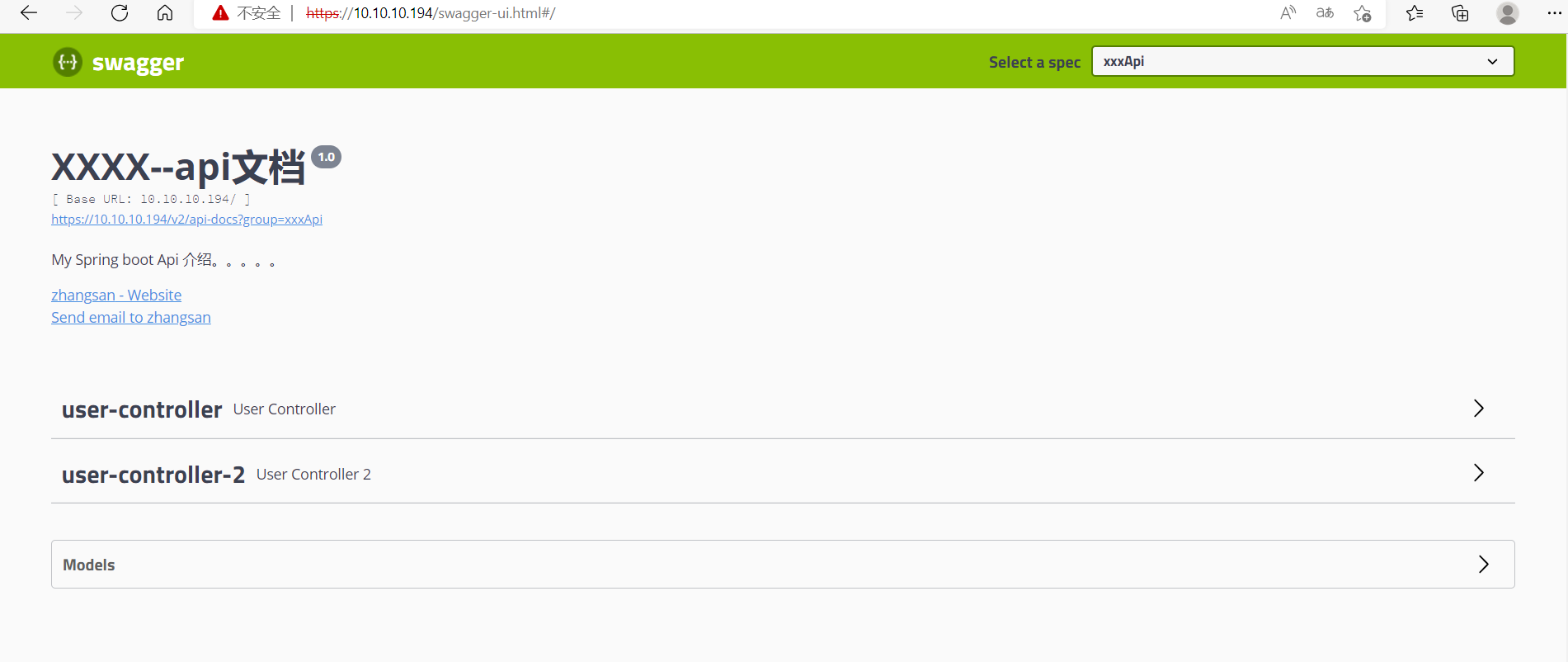目录
■1.前言・Swagger介绍
■2.例子,如果基于Spring Boot项目,实现Swagger---非常简单
2.1.已有的SpringBoot项目
2.2.修改POM文件
2.3.添加Config文件
2.4.访问
2.5.访问效果以及对应的代码
效果
代码
2.6.类的标注
2.7.启动Log
2.8.xxx
2.9.xxx
■3.非Spring 项目中,Swagger的运用
3.0.Sping介绍
3.1.简介
3.2.SwaggerConfig
3.3.配置Swagger相关Bean
3.4.访问
3.5.对于非Spring工程,如何加载Swagger的配置类
3.6.Web工程,如何配置,能让一个类在服务启动的时候,被加载
方法1(最基本方法):
方法2:@WebListener
3.7.ServletContextListener
====
■1.前言・Swagger介绍
项目去IF设计书化,使用Swagger生成API接口。
先了解一下Swagger
Swagger是一组开源工具,用于设计、构建、文档化和测试RESTful API。它提供了一种基于JSON或YAML格式的API描述语言,可以定义API的操作、参数、响应和安全规范,并生成易于阅读和交互的API文档。Swagger还提供了一组可视化工具,包括Swagger UI和Swagger Editor,可以帮助开发人员快速构建和测试API。使用Swagger可以提高API的可读性、可维护性和交互性,从而促进API的开发和使用。
学习资料
官方文档:Swagger Documentation
Swagger Editor:Swagger Editor
Swagger UI:REST API Documentation Tool | Swagger UI
使用Swagger自动生成API文档:https://www.cnblogs.com/kevingrace/p/7883099.html
使用Swagger构建RESTful API:https://www.jianshu.com/p/9b1b75b4f3ea
Swagger入门教程:https://www.cnblogs.com/panpanwelcome/p/10094733.html
Swagger的使用及其原理简介:https://www.jianshu.com/p/a5f6e5e9f4cf
Spring Boot集成Swagger:https://www.jianshu.com/p/03c7b314d1f8
===
■2.例子,如果基于Spring Boot项目,实现Swagger---非常简单
2.1.已有的SpringBoot项目
SpringBoot + Thymeleaf 之 HelloWorld_sun0322的博客-CSDN博客
====
2.2.修改POM文件
<!--swagger依赖--><dependency><groupId>io.springfox</groupId><artifactId>springfox-swagger2</artifactId><version>2.9.2</version></dependency><!--swagger ui--><dependency><groupId>io.springfox</groupId><artifactId>springfox-swagger-ui</artifactId><version>2.9.2</version></dependency>===
2.3.添加Config文件
package com.sxz.test.one.config;import org.springframework.context.annotation.Bean;
import org.springframework.context.annotation.Configuration;import com.google.common.base.Predicates;import springfox.documentation.builders.ApiInfoBuilder;
import springfox.documentation.builders.PathSelectors;
import springfox.documentation.builders.RequestHandlerSelectors;
import springfox.documentation.service.ApiInfo;
import springfox.documentation.service.Contact;
import springfox.documentation.spi.DocumentationType;
import springfox.documentation.spring.web.plugins.Docket;
import springfox.documentation.swagger2.annotations.EnableSwagger2;@Configuration
@EnableSwagger2
public class Swagger2Config {/*** 创建API应用* apiInfo() 增加API相关信息* 通过select()函数返回一个ApiSelectorBuilder实例,用来控制哪些接口暴露给Swagger来展现,* 指定扫描的包路径来定义指定要建立API的目录。* @return*/@Beanpublic Docket coreApiConfig(){return new Docket(DocumentationType.SWAGGER_2).apiInfo(adminApiInfo()).groupName("xxxApi").select()//只显示user下面的路径.paths(Predicates.and(PathSelectors.regex("/user/.*"))).apis(RequestHandlerSelectors.basePackage("com.sxz")).build();}private ApiInfo adminApiInfo(){return new ApiInfoBuilder().title("XXXX--api文档").description("My Spring boot Api 介绍。。。。。").version("1.0").contact(new Contact("zhangsan","https://blog.csdn.net/sxzlc","123456789@sun.com")).build();}
}
===
2.4.访问
https://10.10.10.194/swagger-ui.html#/

===
2.5.访问效果以及对应的代码
效果

代码
package com.sxz.test.one.controller;import java.util.List;import org.springframework.beans.factory.annotation.Autowired;
import org.springframework.stereotype.Controller;
import org.springframework.ui.Model;
import org.springframework.web.bind.annotation.RequestMapping;import com.sxz.test.one.entity.User;
import com.sxz.test.one.service.UserService;import io.swagger.annotations.Api;
import io.swagger.annotations.ApiOperation;
import io.swagger.annotations.ApiParam;
import lombok.extern.slf4j.Slf4j;@Api(value = "User Info")
@Controller
@RequestMapping("/user")
@Slf4j
public class UserController2 {@AutowiredUserService userService;@ApiOperation(value = "All User Info",notes = "Find All User Info")@RequestMapping("/findAll2")public String findAll(@ApiParam(value = "Model",required = true,example = "example model")Model model){log.info("Hello World !-------!");List<User> userList = userService.findAll();model.addAttribute("userList",userList);return "helloThymeleafMyBatis.html";}
}
xxx
2.6.类的标注
xxxx
在完成了上述配置后,其实已经可以生产文档内容,但是这样的文档主要针对请求本身,描述的主要来源是函数的命名,通常需要自己增加一些说明来丰富文档内容。
Swagger使用的注解及其说明:
@Api:用在类上,说明该类的作用。
@ApiOperation:注解来给API增加方法说明。
@ApiParam:定义在参数上
@ApiResponses:用于表示一组响应
@ApiResponse:用在@ApiResponses中,一般用于表达一个错误的响应信息
l code:数字,例如400
l message:信息,例如"请求参数没填好"
l response:抛出异常的类@ApiModel:描述一个Model的信息(一般用在请求参数无法使用@ApiImplicitParam注解进行描述的时候)
l @ApiModelProperty:描述一个model的属性
@ApiImplicitParams: 用在方法上包含一组参数说明。
@ApiImplicitParam:用来注解来给方法入参增加说明。
@ApiImplicitParam的参数说明:
paramType:指定参数放在哪个地方
header:请求参数放置于Request Header,使用@RequestHeader获取 query:请求参数放置于请求地址,使用@RequestParam获取 path:(用于restful接口)–>请求参数的获取:@PathVariable body:(不常用) form(不常用)
name:参数名
dataType:参数类型
required:参数是否必须传
true | false
value:说明参数的意思
defaultValue:参数的默认值
xxxx
2.7.启动Log
。。。。。。。
[2023-07-31 19:04:20.990] [level: INFO] [Thread: main] [ Class:org.springframework.boot.web.servlet.context.ServletWebServerApplicationContext >> Method: prepareWebApplicationContext:285 ]
INFO:Root WebApplicationContext: initialization completed in 5824 ms
[2023-07-31 19:04:24.578] [level: INFO] [Thread: main] [ Class:springfox.documentation.spring.web.PropertySourcedRequestMappingHandlerMapping >> Method: initHandlerMethods:69 ]
INFO:Mapped URL path [/v2/api-docs] onto method [springfox.documentation.swagger2.web.Swagger2Controller#getDocumentation(String, HttpServletRequest)]
[2023-07-31 19:04:24.889] [level: INFO] [Thread: main] [ Class:org.springframework.scheduling.concurrent.ThreadPoolTaskExecutor >> Method: initialize:181 ]
INFO:Initializing ExecutorService 'applicationTaskExecutor'
[2023-07-31 19:04:25.143] [level: INFO] [Thread: main] [ Class:org.springframework.boot.autoconfigure.web.servlet.WelcomePageHandlerMapping >> Method: <init>:53 ]
INFO:Adding welcome page: class path resource [static/index.html]
。。。。。。。
2.8.xxx
xxxx
2.9.xxx
xxxx
===
■3.非Spring 项目中,Swagger的运用
3.0.Sping介绍
Spring Boot,Sprint Batch,ThymeLeaf 学习_sun0322的博客-CSDN博客
xxxx
3.1.简介
Swagger是一种用于创建、文档化和测试Restful API的工具,不限于特定的框架或工程。即使你的web工程不是基于Spring或Spring Boot的,你仍然可以使用Swagger来实现API文档化和测试。
如果你的web工程不是基于Spring或Spring Boot的,你可以使用Swagger2配置Swagger,提供API文档化和测试的功能。下面给出一个示例配置:
xxxx
3.2.SwaggerConfig
import org.springframework.context.annotation.Configuration;
import springfox.documentation.builders.ApiInfoBuilder;
import springfox.documentation.builders.PathSelectors;
import springfox.documentation.builders.RequestHandlerSelectors;
import springfox.documentation.service.ApiInfo;
import springfox.documentation.spi.DocumentationType;
import springfox.documentation.spring.web.plugins.Docket;
import springfox.documentation.swagger2.annotations.EnableSwagger2;@Configuration
@EnableSwagger2
public class SwaggerConfig {public Docket api() {return new Docket(DocumentationType.SWAGGER_2).select().apis(RequestHandlerSelectors.basePackage("com.example.api")) // 修改为你的API接口所在的包路径.paths(PathSelectors.any()).build().apiInfo(apiInfo());}private ApiInfo apiInfo() {return new ApiInfoBuilder().title("API文档").description("描述你的API").version("1.0").build();}
}xxxx
3.3.配置Swagger相关Bean
import org.springframework.context.annotation.Bean;
import org.springframework.context.annotation.Configuration;@Configuration
public class AppConfig {@Beanpublic SwaggerConfig swaggerConfig() {return new SwaggerConfig();}
}===
3.4.访问
启动工程并访问Swagger UI:当你的工程启动后,你可以通过访问Swagger UI来查看生成的API文档。Swagger UI的访问地址一般是
http://localhost:port/swagger-ui.html,其中port是你的web应用的端口号。==
需要注意的是,以上示例代码是以Java配置的方式示范,如果你的工程使用其他配置方式(如XML配置),你需要相应地进行调整。
==
以上是一个基本的Swagger2配置示例,通过在工程中配置Swagger,你可以实现API文档化和测试的功能。具体的配置细节可能会因为工程的不同而有所差异,你可以根据Swagger官方文档或相关的API文档进行调整和修改。
xxxx
3.5.对于非Spring工程,如何加载Swagger的配置类
对于非Spring工程,如果你想要让程序加载Swagger的配置类
public class MainClass {public static void main(String[] args) throws Exception {Class<?> swaggerConfigClass = Class.forName("你的包名.SwaggerConfig"); // 修改为SwaggerConfig类所在的包名}
}xxx
调用SwaggerConfig类的api()方法:通过反射调用SwaggerConfig类中的api()方法来获取Docket对象。
public class MainClass {public static void main(String[] args) throws Exception {Class<?> swaggerConfigClass = Class.forName("你的包名.SwaggerConfig"); // 修改为SwaggerConfig类所在的包名Object swaggerConfigObject = swaggerConfigClass.newInstance();Method apiMethod = swaggerConfigClass.getDeclaredMethod("api");Docket docket = (Docket) apiMethod.invoke(swaggerConfigObject);}
}使用Docket对象进行Swagger的配置和初始化。
public class MainClass {public static void main(String[] args) throws Exception {Class<?> swaggerConfigClass = Class.forName("你的包名.SwaggerConfig"); // 修改为SwaggerConfig类所在的包名Object swaggerConfigObject = swaggerConfigClass.newInstance();Method apiMethod = swaggerConfigClass.getDeclaredMethod("api");Docket docket = (Docket) apiMethod.invoke(swaggerConfigObject);// 根据你的实际需求,进行其他的Swagger配置(例如设置路径,设置API文档信息等)// 初始化SwaggerSwagger swagger = docket.initialize();// 可以根据需要将Swagger对象保存下来,供其他需要使用Swagger的地方使用}
}sss
以上是在非Spring工程中手动加载Swagger配置类的方法,你可以根据实际情况进行调整。需要注意的是,这种方式需要手动处理加载和初始化,相对于Spring工程中的自动注入来说,比较繁琐。如果你的项目是非常简单的项目,也可以考虑使用Spring或Spring Boot来简化Swagger的配置和集成。
3.6.Web工程,如何配置,能让一个类在服务启动的时候,被加载
方法1(最基本方法):
首先,创建一个类实现
javax.servlet.ServletContextListener接口并重写contextInitialized方法,该方法会在Web应用启动时被调用。在该方法中,你可以执行你想要在服务启动时加载的逻辑。
↓
import javax.servlet.ServletContextEvent;
import javax.servlet.ServletContextListener;public class MyServletContextListener implements ServletContextListener {@Overridepublic void contextInitialized(ServletContextEvent servletContextEvent) {// 这里写你想要在服务启动时加载的逻辑}@Overridepublic void contextDestroyed(ServletContextEvent servletContextEvent) {// 服务关闭时的逻辑}
}然后,在
web.xml中配置该监听器。找到web.xml文件,添加以下代码:
<listener><listener-class>你的包名.MyServletContextListener</listener-class> <!-- 修改为你的类的全限定名 -->
</listener>xxx
当你的Web应用启动时,
MyServletContextListener类的contextInitialized方法将会被调用,在该方法中可以执行你想要在服务启动时加载的逻辑。===
方法2:@WebListener
注意:在最新的Servlet规范和Servlet 3.0之后,你还可以使用注解的方式配置
ServletContextListener。你可以在想要加载的类上添加@WebListener注解,并将其放置在类上方。
xxx
import javax.servlet.annotation.WebListener;
import javax.servlet.ServletContextEvent;
import javax.servlet.ServletContextListener;@WebListener
public class MyServletContextListener implements ServletContextListener {@Overridepublic void contextInitialized(ServletContextEvent servletContextEvent) {// 这里写你想要在服务启动时加载的逻辑}@Overridepublic void contextDestroyed(ServletContextEvent servletContextEvent) {// 服务关闭时的逻辑}
}↑
这种方式更简洁,并且不需要在
web.xml中进行配置。无论是使用
web.xml配置还是使用注解配置ServletContextListener,都可以达到在Web服务启动时加载某个类的目的。
xxx
3.7.ServletContextListener

===
* DO NOT ALTER OR REMOVE COPYRIGHT NOTICES OR THIS HEADER.package javax.servlet;import java.util.EventListener;/** * Interface for receiving notification events about ServletContext* lifecycle changes.** <p>In order to receive these notification events, the implementation* class must be either declared in the deployment descriptor of the web* application, annotated with {@link javax.servlet.annotation.WebListener},* or registered via one of the addListener methods defined on* {@link ServletContext}.** <p>Implementations of this interface are invoked at their* {@link #contextInitialized} method in the order in which they have been* declared, and at their {@link #contextDestroyed} method in reverse* order.** @see ServletContextEvent** @since Servlet 2.3*/
public interface ServletContextListener extends EventListener {/*** Receives notification that the web application initialization* process is starting.** <p>All ServletContextListeners are notified of context* initialization before any filters or servlets in the web* application are initialized.** @param sce the ServletContextEvent containing the ServletContext* that is being initialized*/public void contextInitialized(ServletContextEvent sce);/*** Receives notification that the ServletContext is about to be* shut down.** <p>All servlets and filters will have been destroyed before any* ServletContextListeners are notified of context* destruction.** @param sce the ServletContextEvent containing the ServletContext* that is being destroyed*/public void contextDestroyed(ServletContextEvent sce);
}xxx
===
)









深度学习基础)


——模拟登录)



_HTTP的请求和响应)

